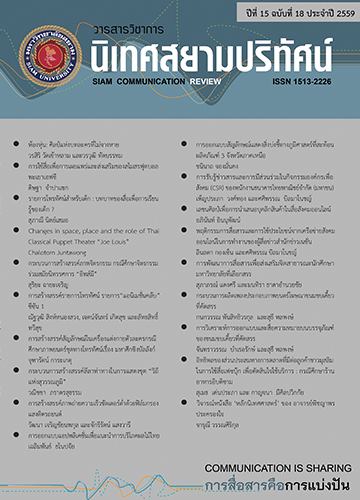ห้องหุ่น: ศิลป์แห่งบทละครที่ไม่จางหาย
Main Article Content
บทคัดย่อ
งานวิจัยเรื่อง ห้องหุ่น: ศิลป์แห่งบทละครที่ไม่จางหาย เป็นการศึกษาโดยใช้ระเบียบวิธีวิจัยเชิงคุณภาพ มีวัตถุประสงค์เพื่อวิเคราะห์กระบวนการในการสร้างสรรค์สุนทรียะ เรื่อง ห้องหุ่น โดยศึกษาผ่านการเล่าเรื่องในบทละครวิทยุ ละครโทรทัศน์ และภาพยนตร์ที่นำบทละครวิทยุมาดัดแปลง และเพื่อส่งเสริมและพัฒนาคุณธรรมของคนไทย ผ่านการตีความหมายในสารเพื่อการขัดเกลาทางสังคมในบทละครวิทยุ ละครโทรทัศน์ และภาพยนตร์เรื่องห้องหุ่น ทั้งนี้ผู้วิจัยได้ใช้วิธีการวิเคราะห์เนื้อหา เป็นหลักในการทำการวิจัยครั้งนี้ และใช้ข้อมูลสัมภาษณ์ เอกสารที่เกี่ยวข้องมาสนับสนุนการวิเคราะห์ โดยใช้แนวคิดการประกอบสร้างความเป็นจริงทางสังคม แนวคิดการเล่าเรื่อง แนวคิดเทคโนโลยีการสื่อสารเป็นตัวกำหนดและแนวคิดสารเพื่อการ ขัดเกลาทางสังคม มาเป็นกรอบการศึกษา ผลการศึกษาพบว่า การสร้างสรรค์เรื่องห้องหุ่นมาจากตัวบทต้นทางคือบทละครวิทยุคณะกันตนาโดยผู้ประพันธ์คือคุณสมสุข กัลย์จาฤก ได้รับแรงบันดาลใจจากเรื่องเล่าของบุคคลรอบข้างผนวกกับจินตนาการของผู้เขียน เมื่อมาทำเป็นละครโทรทัศน์ใน พ.ศ.2546 ยัง “คงเดิม” ในส่วนของแก่นเรื่องและโครงเรื่องอยู่ ในขณะเดียวกันส่งทอดต่อมายังสื่อภาพยนตร์ใน พ.ศ. 2557 ที่ยังคงแก่นเรื่องกฎแห่งกรรม การทำดี การทำชั่ว ไว้เป็นสารที่ “ปรับการนำเสนอโครงเรื่องใหม่”เพื่อให้ถ่ายทอดเรื่องราวตามบริบทของสังคมในแต่ละยุค นอกจากนี้ประสบการณ์ของผู้สร้างหรือผู้ผลิตเป็นปัจจัยสำคัญในการผลิต และส่งความหมายของสารห้องหุ่นไปยังผู้รับสาร จนเกิดการสร้างชุดของความจริงหรือชุดความรู้ให้กับสังคม ได้แก่การให้ความสำคัญเรื่องการศึกษาและเรื่องครอบครัว ซึ่งเท่ากับว่าเรื่องห้องหุ่นได้ทำหน้าที่ของสื่อมวลชนในแง่ของการช่วยให้สังคมอยู่ในกรอบหรือบรรทัดฐานที่วางไว้ได้ อาจกล่าวได้ว่า การศึกษาบทละครวิทยุ บทละครโทรทัศน์ และบทภาพยนตร์เรื่องห้องหุ่น เปรียบเสมือนหน้าต่างที่เปิดไปสู่โลกกว้าง ทำให้คนเราได้รู้เห็นความเป็นจริงทางสังคมมากขึ้น
Article Details
เอกสารอ้างอิง
กาญจนา แก้วเทพ. (2541). สื่อสารมวลชน: ทฤษฎีและแนวทางการศึกษา. กรุงเทพฯ: ภาพพิมพ์.
กาญจนา แก้วเทพ และ สมสุข หินวิมาน. (2553). สายธารนักคิดทฤษฎีเศรษฐศาสตร์การเมืองกับสื่อสารศึกษา. กรุงเทพฯ: ภาพพิมพ์.
ขจีรัตน์ หินสุวรรณ.(2542).การวิเคราะห์วิธีการเขียนบทละครสำหรับสื่อมวลชน: บทเรียนจากงานของ
สมสุข กัลย์จาฤก. (วิทยานิพนธ์ปริญญามหาบัณฑิต). จุฬาลงกรณ์มหาวิทยาลัย,คณะนิเทศศาสตร์,สาขาสื่อสารมวลชน.
วรวุฒิ ทัดบรรทม และวรสิริ วัดเข้าหลาม.(2556). ผลงานสร้างสรรค์บทละครวิทยุคณะกันตนา. สถาบันกันตนา, คณะศิลปกรรมการผลิตสื่อ.
ศิวะพร หงส์จินดาเกศ. (2537). วิถีชีวิตประจำวันที่แสดงออกทางวาทกรรมในละครวิทยุคณะเกศทิพย์ พ.ศ. 2536. (วิทยานิพนธ์ปริญญามหาบัณฑิต).จุฬาลงกรณ์มหาวิทยาลัย, คณะนิเทศศาสตร์, สาขาวิชาสื่อสารมวลชน.
สุภา จิตติวสุรัตน์. (2545). การสร้างความหมายทางสังคมและการรับรู้ความเป็นจริงในภาพยนตร์เรื่องจริง. (วิทยานิพนธ์ปริญญามหาบัณฑิต). จุฬาลงกรณ์มหาวิทยาลัย, คณะนิเทศศาสตร์,สาขาสื่อสารมวลชน.
อภิญญา ศรีรัตนสมบุญ.(2534). การวิเคราะห์ละครโทรทัศน์ ชุด คู่กรรม ในการถ่ายทอดความเชื่อและค่านิยมในสังคมไทย (วิทยานิพนธ์ปริญญามหาบัณฑิต).จุฬาลงกรณ์มหาวิทยาลัย, คณะนิเทศศาสตร์, สาขาวิชานิเทศศาสตร์.
อุบลรัตน์ ศิริยุวศักดิ์ และคณะ. (2542). จินตทัศน์ทางสังคมในภาษาสื่อมวลชนฯ.กรุเทพฯ : โครงการสื่อสันติภาพ คณะนิเทศศาสตร์ จุฬาลงกรณ์มหาวิทยาลัย.
ภาษาอังกฤษ
Berger&Luckmann (1966).The Social Construction of Reality: A Treatise in the Sociology of Knowledge.New York: Penguin Books.
Landis, Judson R. (1986). Sociology: Concepts and Characteristics. 6th ed. New York: Wadsworth.
McQuail, D. (2010). McQuail's mass communication theory. 6th ed. London : Sage Publications,:
Wilbur,S. (1964). Mass Media and National Development .California: Stanford University Press.


